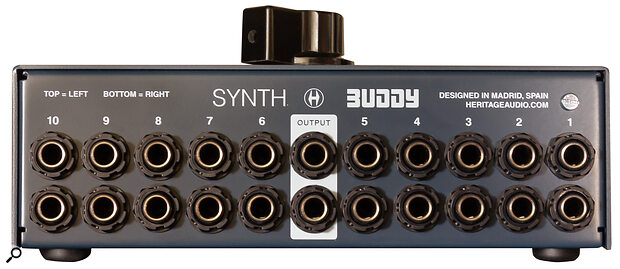The Heritage Audio Synth Buddy uses only passive circuitry, and that means that it can be used with all manner of unbalanced audio signals, including synths and guitars. It also means that it can operate in either direction — so you can select which of up to 10 mono or stereo sources are routed to a single destination, or route one instrument to your choice of up to 10 destinations. For example, I was able to sit it on my guitar pedalboard and use it to route the main output signal to the various different amps and amp emulation hardware that’s set up in my studio. I was also able to use it to feed different sources to my looper pedal.
The I/O are all on the back panel, laid out as vertically stacked pairs of TS sockets. The upper row is labelled as the left channel and the lower as right, though there’s nothing to stop you reversing that. The ‘output’, which could equally well be used as the single input, is in the middle, with five pairs for ‘the other end’ either side. On the top, you turn a large chicken‑head knob, which operates a switch that changes the routing. Everything’s clearly labelled, so you’re never in any doubt about which numbered source is selected, or which physical jack leads for that matter. (That said, one change I’d like to see here is a ‘scribble strip’ or space at the top to accommodate user labelling.)
 The I/O are on unbalanced TS jacks on the rear, with two rows to accommodate stereo signals (you can, of course, use just a single row for mono source‑to‑destination switching.
The I/O are on unbalanced TS jacks on the rear, with two rows to accommodate stereo signals (you can, of course, use just a single row for mono source‑to‑destination switching.
The switching itself makes a quiet acoustic click, which gives reassuring confirmation that you’ve changed position. In terms of the impact of switching on the audio signal, it is almost silent — it never caused the sort of loud nasty pops that could make your heart skip a beat or damage a speaker, but there’s always a quiet ‘click’ when you change the signal path. As it is audible, it’s worth knowing about and, for example if planning to switch sources/destinations during rather than in between performances you’ll want to weigh up whether this is for you. Personally, I reckon it’s quiet enough that if I made the change on a beat few people listening would notice, but our personal mileages may vary on that point.
There are some other practical considerations. As with any passive system, long cables running to/from it could have an impact on tone, for example. And while the unit does look very neat on its own, remember that you can have as many as 22 cables trailing from the back. There are rubber feet that help to keep it in place on a desktop, but you’re going to want to consider cable dressing if you like to keep things tidy.
For anyone with a smaller audio interface and a collection of guitars, pedals, synths and drum machines, the appeal should be obvious.
Personally, I didn’t find any of that a problem. In fact, the biggest challenge for me was removing the 16 screws and the main knob and the nut that holds the pot in place so I could see what was going on inside, which no user should need to do! For its main declared purpose — patching synth sources to an audio interface or other destination — the Synth Buddy works really well. For anyone with a smaller (eg. two‑input) audio interface and a collection of guitars, pedals, synths and drum machines, then, the appeal should be obvious: you can leave everything hooked up to the Synth Buddy and simply turn the big chicken‑head knob to choose which source is routed to your interface, making it quick, easy and convenient to overdub different parts. No patching or mixer routing required, and you don’t need a bigger, more expensive interface with lots of I/O.
 A peep inside reveals neat but simple construction, with the large rotary switch attached to a single circuit board, to which the jack sockets are also soldered.
A peep inside reveals neat but simple construction, with the large rotary switch attached to a single circuit board, to which the jack sockets are also soldered.
Verdict?
Some might consider the headline price on the chunky side for what, at the end of the day, is a simple switch in a box: it retails for about the same price as some budget eight‑channel interfaces, for example, or double the price of some of the more affordable jack patchbays out there. But it allows you to handle more physical inputs than such an interface, and it’s more convenient than plugging and unplugging patch cords. The 22 jacks, good‑quality switch and robust steel enclosure account for a good chunk of the asking price, and, frankly, if I were to price up the time it would take me to make something like this I’d quickly conclude that it really wouldn’t be worth the bother. All in all then, I reckon this is a great idea, and it’s been executed in a way that could meet a lot of people’s needs.
Information
£185 including VAT.
$199
When you purchase via links on our site, SOS may earn an affiliate commission. More info...

